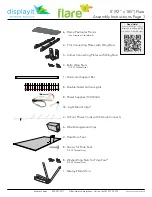
15
DESHU - October 2015
Technical instructions
for Installation
1.7/ Emergency fi rst aid procedure
Handling precautions provide reliable protection against risks for health. However, if an emergency occurs,
stay calm and act cautiously. Proceed as explained below and seek medical advice.
IF INHALED:
Remove person to fresh air and keep him/her warm and let him/her rest. Apply artifi cial respiration
if breathing becomes irregular or stops. In case of cardiac arrest, proceed with cardiac massage.
IF ON SKIN:
Defrost exposed clothing and skin with water and rinse thoroughly before removing clothes.
!
Warning:
Caution! Frostbite may cause clothing to stick to the skin.
IF IN EYES:
Rinse immediately and thoroughly for at least 10 minutes using clear water or an eye-cleaning
solution.
IF SWALLOWED:
Do NOT induce vomiting. If person is conscious, rinse mouth with water and give one glass of
water.
Medical advice:
Administer symptomatic treatment and additional care as indicated. Do not administer
ephedrine or adrenaline products which may cause cardiac arrhythmia, and even cardiac arrest.
2/
Special instructions for chilled water circuits
Chilled water circuits, in particular freon-to-water exchangers, are highly vulnerable to frost damage.
Consequences can be signifi cant: exchanger or compressor replacement, etc. Take all necessary precautions
to avoid such problems.
The installer shall make sure that:
>
Glycol is used as antifreeze protection.
>
Water fl ow rate is suffi cient in each exchanger.
>
Appropriate precautions are taken in case of prolonged shutdown.
Failure to comply with these instructions will void equipment guarantee.
Nota:
ETT will not be liable for frost damage.
The user shall:
• control regularly, using a density meter for example, that the circuit is well protected for the
effective outside temperature;
• start units regularly when shutdown to avoid deterioration;
• drain circuits when necessary (in case of power outage, failure, etc.).



































